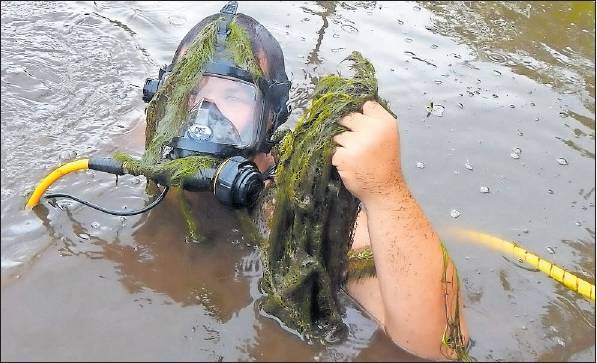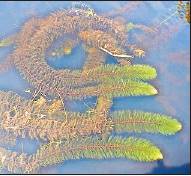Invasive weed choking Maine lakes threatens property values, recreation
DEP official says early detection key to keeping unwanted plant in check
BY LORI VALIGRA
BDN STAFF
Colin Holme watched a little girl walk a few feet into Lake Arrowhead earlier this year and quickly became startled as he saw invasive milfoil plants envelop her.
“It was awful,” said Holme, executive director of the Lakes Environmental Association in Bridgton, which monitors 41 lakes and ponds in southwestern Maine for invasive aquatic plants and water quality. “I remember swimming in lakes when I was younger and how much I disliked swimming through the plants.”
The invasive plants, which are believed to have been brought up from southern states, first appeared in Maine in 2003. While the weed is not known to cause harm to humans, it spreads quickly and is transferred from infested lakes to other ones mostly by uncleaned boats.
Milfoil is in 32 Maine lakes now, four more than before the COVID-19 pandemic, as more people sought outdoor activities like boating and stayed on lakes longer into the fall. Apart from being an eyesore and unpleasant to swim and boat through, widespread milfoil infestations can be costly to homeowners by lowering lakeside property values, studies have found.
Homeowners in Maine’s southern five counties could see property value losses topping $11 million, according to the Maine Department of Environmental Protection. Costs to control invasive species, including milfoil, could eventually reach $4 million per year, it said. That figure does not include losses from tourism, fishing and water sports.
Some areas of Maine already are experiencing the fallout. In 2007, homeowners in Limerick, which borders Lake Arrowhead, successfully petitioned the town to reduce their home assessments 10 percent to 20 percent because of the milfoil in the lake. The manmade lake has had ongoing infestations of milfoil, partly
See Milfoil, Page A2
Continued from Page A1
because it is comparatively shallow so sunshine can reach its bottom and help the plants grow.
There are two invasive species of milfoil in Maine that grow quickly, taking habitat from other plants and making lake life difficult for fish and birds. That includes iconic Maine loons, which need a quarter-mile to land and clear water to see their fish prey in the lake.
The most pervasive milfoil species in Maine is variable leaf milfoil, which is odorless and looks bushy like a raccoon tail in water. It grows in shallower waters toward lakeshores and flowers above the lake surface. It can reach 15 feet long. Eurasian milfoil also is in some lakes and is difficult to eradicate. Both typically grow from May through October.
Milfoil is found from southernmost Maine to Washington County, usually in lakes and rivers easily reached from the Interstate 95 corridor. All New England states, 41 other U.S. states and six Canadian provinces are battling milfoil and other invasive plants.
Holme expects milfoil to keep spreading across Maine. The COVID-19 pandemic brought more motorized boats to lakes as homebound consumers sought outdoor activities, and that increased activity has continued well into the fall. The motorized boats cut apart the mil-foil, helping it spread, Holme said.
Ridding lakes of milfoil is a labor-intensive and ongoing process handled mostly by about a dozen nonprofit groups that are not well-funded despite the relatively low cost to kill the plants, Holme said. About a quarter of the Lakes Environmental Association’s funding comes from the Department of Environmental Protection, which gets money largely from the stickers boat owners must buy and from grants.
The sticker program was passed by the Legislature in 2002 and is funded by fees on motorized watercraft used on inland waters, which are higher for out-of-state registrants. The environmental association also gets money from towns, lakefront homeowners and private donations.
Its largest pot of money is from a private foundation with a board member who is interested in mil-foil. It donated $100,000 each of the first two years and $75,000 for the most recent two. The board member lives in Massachusetts, where almost 10 percent of the state’s 3,000 lakes have infestations.
“He recognized how bad milfoil is in Massachusetts and thought we had a fighting chance in Maine to beat it back,” Holme said.
The rest of the funding comes from soliciting local landowners on lakes like Long Lake, which is surrounded by the towns of Naples, Bridgton and Harrison. But only 16 percent of homeowners contribute, he said. Money from towns also is sparse. Naples, which has the most lakefront property, donates $10,000 annually to the nonprofit, Bridgton $1,500 and Harrison nothing so far.
The association needs about $200,000 per year for control measures and the same for cleanup. Holme is worried about what will happen when the funding from the out-of-state foundation ends.
“Once the funding goes away, the milfoil will come back,” he said.
Prevention is a big part of what the association focuses on, trying to educate boat owners to clean their boats before and after use in a lake. That could be a hose down, wiping them down with a towel or visually inspecting all parts of the boat to see that no milfoil plant fragments are stuck anywhere.
An easy way to think about the cleaning is “clean, drain and dry” before and after each lake visit, said John McPhedran, a biologist in the Department of Environmental Protection’s invasive aquatic species program. Cleaning should be done so that any water used does not go into the lake.
He said early detection is key to keeping milfoil in check. In 2020, the state inspected more than 100,000 boats, most with no invasive aquatic plants on them. An ongoing challenge is thinking of ways to decrease the risk of spread from humans, especially because more people are boating later into the fall. Animals do spread milfoil but not to the degree of boaters, he said.
To rid an infected lake of milfoil, the Lakes Environmental Association does not use chemicals, but has three methods. Divers pull up the milfoil roots and feed the plant through a suction hose that dumps them on the deck of a boat for disposal. In large areas with very few plants, divers pull the plants by hand and bag them. In broad areas where only one type of milfoil is present, it puts in tarp barriers that smother the plants over the winter.
“The long-term prognosis is that unless we bring more funding, more education and more recognition to the problem, it’s only going to get worse,” Holme said. “Eventually we are going to be overwhelmed.”


